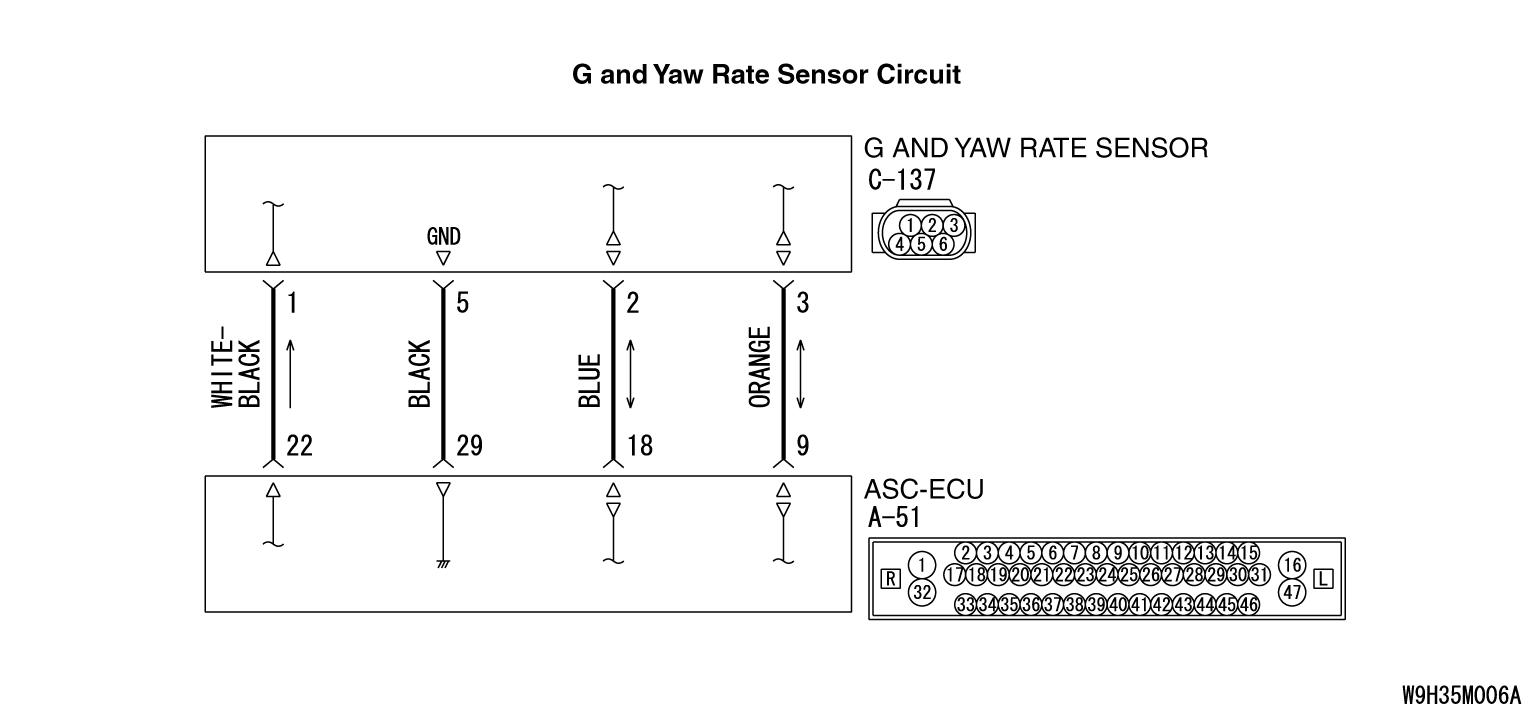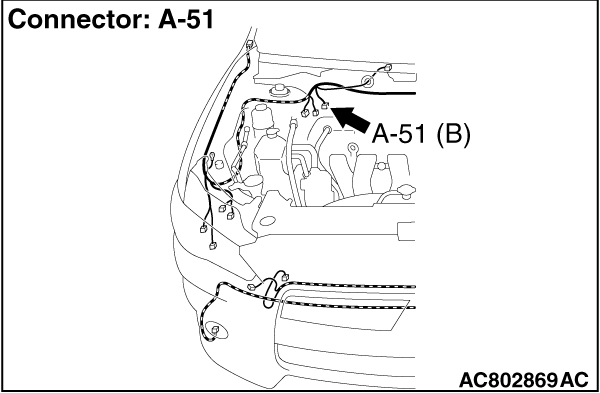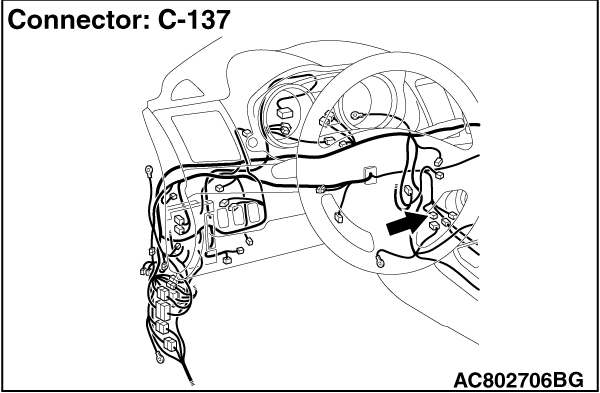![[Previous]](../../../buttons/fprev.png)
![[Next]](../../../buttons/fnext.png)
DTC C2204 Internal
abnormality in G and yaw rate sensor



|
|
| caution |
- If there is
any problem in the CAN bus lines, an incorrect DTC may be set. Prior to this diagnosis, diagnose
the CAN bus lines (Refer to GROUP 54C - Diagnostic trouble code diagnosis
 ). ).
- Whenever ECU is replaced, ensure that the CAN bus lines are normal.
- Do not drop or shock the G and yaw rate sensor.
- When the G and yaw rate sensor is replaced, always carry out calibration to make
ASC-ECU learn the neutral point (Refer to
 ). ).
- When the hydraulic unit (integrated with ASC-ECU) is replaced, always carry out
the calibration of the steering wheel sensor, the G and yaw rate sensor and brake fluid pressure
sensor (Refer to
 , ,  and and  ). ).
|
|
|
|
ABS-ECU monitors if the output of G and yaw rate sensor is normal or not.
|
|
|
This DTC is set if any malfunction below is found:
|
|
|
- When abnormality is detected by the self-diagnosis of
the lateral G and yaw rate
- When the output value of the lateral G and yaw rate is not within the standard value
range
|
|
|
| note |
This DTC may be set when G and yaw rate sensor is put on the turntable turning at high
speed.
|
|
|
|
- Wiring harness or connector failure for the special CAN bus lines between
ASC-ECU and the G and yaw rate sensor
- Improper installation of the G and yaw rate sensor
- Damaged wiring harness and connectors
- G and yaw rate sensor malfunction
- ASC-ECU malfunction
|
|
|
Required Special Tools:
- MB991958: Scan Tool (M.U.T.-III Sub Assembly)
- MB991824: Vehicle Communication Interface (V.C.I.)
- MB991827: M.U.T.-III USB Cable
- MB991910: M.U.T.-III Main Harness A
|
|
|
STEP 1. Using scan tool MB991958, diagnose the CAN bus lines.
|
|
|
Use scan tool to diagnose the CAN bus lines.
|
|
|
Q.
Is the check result normal?
|
|
|
 Go to Step 2. Go to Step 2.
|
|
|
|
|
|
 Repair the CAN bus lines (Refer to GROUP 54C - CAN Bus Diagnostic table Repair the CAN bus lines (Refer to GROUP 54C - CAN Bus Diagnostic table  ).
On completion, go to Step 2. ).
On completion, go to Step 2.
|
|
|
|
|
|
Check that the DTC U0125 is set in ASC-ECU.
|
|
|
 Troubleshoot for the DTC (Refer to Troubleshoot for the DTC (Refer to  ). Then go to
Step 3. ). Then go to
Step 3.
|
|
|
|
|
|
 Go to Step 3. Go to Step 3.
|
|
|
|
|
|
STEP 3. DTC recheck after resetting CAN bus lines
|
|
|
 Go to Step 4. Go to Step 4.
|
|
|
|
|
|
 The procedure is complete. The procedure is complete.
|
|
|
|
|
|
STEP 4. M.U.T.-III data list
|
|
|
Check the following service data (Refer to  ). ).
|
|
|
- Item 08: Lateral G-sensor
- Item 09: G-sensor
- Item 12: Yaw rate sensor
|
|
|
Q.
Is the check result normal?
|
|
|
 Go to Step 8. Go to Step 8.
|
|
|
|
|
|
 Go to Step 5. Go to Step 5.
|
|
|
|
|
|
STEP 5. G and yaw rate sensor installation check
|
|
|
Check that the G and yaw rate sensor is installed correctly.
|
|
|
Q.
Is the check result normal?
|
|
|
 Go to Step 6. Go to Step 6.
|
|
|
|
|
|
 Reinstall the G and yaw rate sensor correctly (Refer to Reinstall the G and yaw rate sensor correctly (Refer to  ),
and then go to Step 8. ),
and then go to Step 8.
|
|
|
|
|
|
STEP 6. Connector check: A-51 ASC-ECU connector, C-137 G and yaw rate
sensor connector
|
|
|
Q.
Is the check result normal?
|
|
|
 Go to Step 7. Go to Step 7.
|
|
|
|
|
|
 Repair the connector, and then go to Step 8. Repair the connector, and then go to Step 8.
|
|
|
|
|
|
STEP 7. Wiring harness check between A-51 ASC-ECU connector terminal
No. 18 and C-137 G and yaw rate sensor connector terminal No. 2 as well as between A-51 ASC-ECU
connector terminal No. 19 and C-137 G and yaw rate sensor connector terminal No. 3
|
|
|
- Check the communication circuit for open and short circuit.
|
|
|
Q.
Is the check result normal?
|
|
|
 Go to Step 8. Go to Step 8.
|
|
|
|
|
|
 Repair the wiring harness, and then go to Step 8. Repair the wiring harness, and then go to Step 8.
|
|
|
|
|
|
STEP 8. Check whether the DTC is reset.
|
|
|
(2)Drive the vehicle at 12mph (20 km/h) or higher.
|
|
|
 Replace the G and yaw rate sensor (Refer to Replace the G and yaw rate sensor (Refer to  ),
and then go to Step 9. ),
and then go to Step 9.
|
|
|
|
|
|
 Intermittent malfunction (Refer to GROUP 00 - How to Use Troubleshooting/How
to Cope with Intermittent Malfunctions Intermittent malfunction (Refer to GROUP 00 - How to Use Troubleshooting/How
to Cope with Intermittent Malfunctions  ). ).
|
|
|
|
|
|
STEP 9. Check whether the DTC is reset.
|
|
|
(2)Drive the vehicle at 12mph (20 km/h) or higher.
|
|
|
 Replace the hydraulic unit (integrated with ASC-ECU) (Refer to Replace the hydraulic unit (integrated with ASC-ECU) (Refer to  ), and
then go to Step 10. ), and
then go to Step 10.
|
|
|
|
|
|
 Intermittent malfunction (Refer to GROUP 00 - How to Cope with Intermittent
Malfunction Intermittent malfunction (Refer to GROUP 00 - How to Cope with Intermittent
Malfunction  ). ).
|
|
|
|
|
|
STEP 10. Check whether the DTC is reset.
|
|
|
(2)Drive the vehicle at 12mph (20 km/h) or higher.
|
|
|
 Return to Step 1. Return to Step 1.
|
|
|
|
|
|
 The procedure is complete. The procedure is complete.
|
|
|
|
![[Previous]](../../../buttons/fprev.png)
![[Next]](../../../buttons/fnext.png)



 Go to Step 2.
Go to Step 2. Repair the CAN bus lines (Refer to GROUP 54C - CAN Bus Diagnostic table
Repair the CAN bus lines (Refer to GROUP 54C - CAN Bus Diagnostic table  ).
On completion, go to Step 2.
).
On completion, go to Step 2. Troubleshoot for the DTC (Refer to
Troubleshoot for the DTC (Refer to  ). Then go to
Step 3.
). Then go to
Step 3. Go to Step 3.
Go to Step 3. Go to Step 4.
Go to Step 4. The procedure is complete.
The procedure is complete. ).
). Go to Step 8.
Go to Step 8. Go to Step 5.
Go to Step 5. Go to Step 6.
Go to Step 6. Reinstall the G and yaw rate sensor correctly (Refer to
Reinstall the G and yaw rate sensor correctly (Refer to  ),
and then go to Step 8.
),
and then go to Step 8. Go to Step 7.
Go to Step 7. Repair the connector, and then go to Step 8.
Repair the connector, and then go to Step 8. Go to Step 8.
Go to Step 8. Repair the wiring harness, and then go to Step 8.
Repair the wiring harness, and then go to Step 8. Replace the G and yaw rate sensor (Refer to
Replace the G and yaw rate sensor (Refer to  ),
and then go to Step 9.
),
and then go to Step 9. Intermittent malfunction (Refer to GROUP 00 - How to Use Troubleshooting/How
to Cope with Intermittent Malfunctions
Intermittent malfunction (Refer to GROUP 00 - How to Use Troubleshooting/How
to Cope with Intermittent Malfunctions  ).
). Replace the hydraulic unit (integrated with ASC-ECU) (Refer to
Replace the hydraulic unit (integrated with ASC-ECU) (Refer to  ), and
then go to Step 10.
), and
then go to Step 10. Intermittent malfunction (Refer to GROUP 00 - How to Cope with Intermittent
Malfunction
Intermittent malfunction (Refer to GROUP 00 - How to Cope with Intermittent
Malfunction  ).
). Return to Step 1.
Return to Step 1. The procedure is complete.
The procedure is complete.